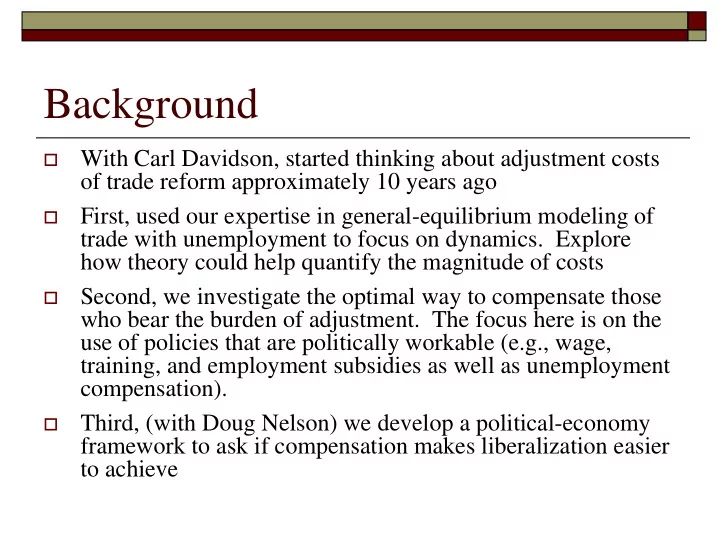

Background With Carl Davidson, started thinking about adjustment costs of trade reform approximately 10 years ago First, used our expertise in general-equilibrium modeling of trade with unemployment to focus on dynamics. Explore how theory could help quantify the magnitude of costs Second, we investigate the optimal way to compensate those who bear the burden of adjustment. The focus here is on the use of policies that are politically workable (e.g., wage, training, and employment subsidies as well as unemployment compensation). Third, (with Doug Nelson) we develop a political-economy framework to ask if compensation makes liberalization easier to achieve
Within-Sector Dynamics i i b b L L t t i i Ei Ei L Ti L Ti t t e e L L t t Training Training Unemployed Unemployed Employed Employed i i i i Ui Ui b b 1 1 L L t t i i i i Ui Ui Much of our research looks only at limit as t goes to infinity But implied differential equations have closed-form solutions if transition rates are time-invariant Multiple sectors connected with worker-indifference and free- entry conditions i sector e , b , transition rates skill retention
Conceptualizing Adjustment Cost Y AI Y AI t t Y Y FT FT Y Y TD TD time time Start from Tariff-Distorted Equilibrium Trade reform causes steady-state value of Free-Trade income to jump up Factor market frictions slow the adjustment Actual Income gradually approaches the new steady state
Conceptualizing Adjustment Cost Y AI Y AI t t Y Y FT FT Y Y TD TD time time Gain from trade is PDV of area between Free-Trade income and Tariff-Distorted income Aggregate adjustment cost is PDV of area between Free- Trade Income and Actual Income
Sample Results Construction of model guarantees that adjustment costs are less than gross benefit of trade reform (no distortions other than initial tariff) However, calibration exercises indicate that adjustment costs can be a very large share of that benefit (30% - 80%) The magnitude of adjustment cost is sensitive to assumptions regarding the magnitude of training costs (in our estimation, we alternatively assume these costs as 1 month of average pay and 15 months of average pay) In the model, training cost is a loss (not part of income)
Optimal Compensation The model is conducive to exploring different ways of compensating those who bear the burden of adjustment (the “movers”) Can compare cost of different policies (wage, employment, or training subsidies, unemployment compensation Basic takeaway is that the optimal policy has a big impact on the average mover (so that only a small program is required) but a small impact on the “marginal” mover so that the number of policy-induced movers is minimized Depending on initial parameters, cost of compensation ranges from roughly 1% to 30% of gross gain from trade (if correct policy is chosen). But mistakes are costly.
Current Work Working with Carl Davidson, Fredrik Heyman, Fredrik Sjöholm, and Susan Zhu Merge Melitz-type model of monopolistic competition and random productivity with Albrecht-Vroman model of technology choice and unemployment. Equilibrium of interest has both unemployment and underemployment (high- skilled workers employed at low-tech firms) Use model to guide analysis of Swedish matched worker-firm data Currently, model only focuses on steady states, though it is simple enough (35 equations in 35 unknowns!) that it can ultimately be re-tooled to look at the dynamics
Future Directions Menezes-Filho and Muendler (2007) suggests importance of adding self-employment or an informal sector Also suggests that accession rates and separation rates depend on worker characteristics (model already incorporates worker heterogeneity) The evidence suggests that increased productivity in the wake of trade reforms lead firms in export-oriented sectors to reduce employment at higher rates than the average Brazilian firm. These firms also had accession rates lower than the average Brazilian firm. Suggests usefulness of adding Melitz-type productivity effect (in progress)
Calibration Complements Estimation Approach is not a substitute for empirical work (no confidence intervals around estimates, etc.) Approach is complementary to empirical work (develops understanding of general-equilibrium connections and interactions with labor market policies and institutions) Quantitative implementation relies on empirical estimates of transition rates and costs of training There is a lot of work on job destruction, much less on other transitions and on training costs
Alternative Apporach McLaren, Artuç, Chaudhuri, and Cameron develop model where workers have idiosyncratic moving costs No unemployment, but shocks to the economy lead to gradual adjustment Neoclassical nature of the model allows application of standard econometric techniques Using CPS data, they estimate mean and variance of workers’ switching costs. Both are very high, implying slow adjustment But simulations reveal that liberalization is Pareto improving
Recommend
More recommend